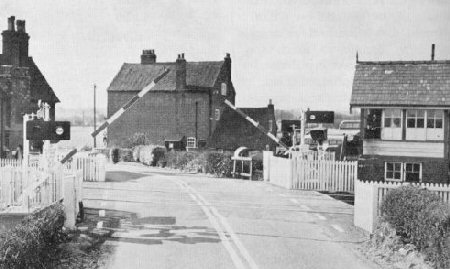
Spath Crossing in the Summer of 1961 whilst attendance was still provided.
BR Official / Nick Allsop Collection

Sam Hallas' Website
Britain's First Automatic Level Crossing
On Sunday 5th February 1961 the first automatic level crossing in Britain was brought into use. Whilst the technical nitty-gritty has been common knowledge for many years, it is only now that the Ministry of Transport files at the Public Record Office have been opened under the Thirty-Year Rule, that we can learn how and why this insignificant crossing in rural Staffordshire came to make British railway history.

Spath Crossing in the Summer of 1961 whilst attendance was still provided.
BR Official / Nick Allsop Collection
Since the earliest days of Railway Mania it was accepted practice that road users should give way to rail traffic where they crossed on the level. To state the obvious, a train cannot stop or manoeuvre as readily as a road user, no mater what form of transport that road user may be employing.
The safety arguments for road traffic yielding to trains are as strong today as they ever were in the 19th Century. The same cannot be said of the patience of the road user. The post war years have seen an inexorable rise in road traffic with a proportional decline in railway traffic. It is no surprise then that even by the 1950's the tide of public opinion was turning against the railway.
In an attempt to reduce the increasing delay to road traffic at railway level crossings, as early as 1954 the Ministry of Transport was tinkering with the long held traditions of the railway. As a counter to wandering animals (and people) it had been a requirement that the railway be securely fenced-in. Where there was a break in the fence to allow people to cross then there had to be a gate which was invariably fastened across the railway or the road but never left open to both.
The first attempt to lessen the delay to the road user was to dispense with the need to swing heavy wooden gates through 90° before and after the passage of a train. This was done by 'allowing' the railway to install lifting barriers which would save the road user a few precious seconds. Of course the advantage to the railway was minimal. These barriers could only be used as a substitute for gates at manned crossing. There was no saving in what was becoming the most expensive resource – labour.
By this time, the railways and roads were both effectively controlled by the Ministry of Transport. In the case of the railway there was an additional strata of government in the form of the British Transport Commission, but ultimately, the Ministry ruled both roosts. All of which meant that both parties had a vested interest in automating level crossings – savings in time for the road user and savings in wages for the railway.
In 1956 a party of Civil Servants from the Ministry and Railwaymen set off on a fact finding tour of Europe to see what was going on over there and to explore if, and how, Continental practices could be applied to the British way of working. One member of the party was E.G.Brentnall OBE, the Chief Signal & Telecommunication Engineer for the London Midland Region.
This resulted in an Act of Parliament in 1957 which empowered the Minister of Transport to authorise "specially safety arrangements at public level crossings such as automatically or remotely operated barriers". A series of "Provisional Requirements" were circulated to the railway by the Ministry of Transport on 1st May 1958.
It was no surprise to the Railway Inspectorate of the Ministry of Transport, therefore, when they received a letter from London Midland Region dated 15th April 1959 applying for permission to provide "an Automatically Operated Barrier Installation" at Spath in Staffordshire.
Curiously, the reason the LMR gave for seeking permission to automate this crossing was that "Spath signalbox and frame are due for renewal in 1959. The box is, however, no longer necessary as a block post, so that the only reason for renewing it would be to control the level crossing. It is considered the crossing is suitable for the provision of automatically-operated lifting half-barriers". To suggest that the box was life-expired is a quite amazing statement especially when one contrasts the age and condition of Spath box with many of the other ex-North Stafford boxes in the area.
Text © Dave Harris. Photos: as attributed